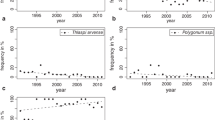Abstract
A weed survey methodology was used for 2 years in three provinces in Greece to determine the abundance and spatial distribution of weeds in cotton (Gossypium hirsutum L.) fields. Based on a stratified random sampling procedure, the most frequently occurring weeds were counted in 150 cotton fields. The field surveys were conducted late in the growing season; hence, the weed populations consisted of species that had been present during the critical competitive period for the crop and may have contributed to yield losses.Solanum nigrum was the most abundant weed in the surveyed fields of the southern province, followed byCyperus rotundus, Convolvulus arvensis, Xanthium strumarium, Chrozophora tinctoria andCynodon dactylon, in descending order. The ranked weed flora in the fields of the northern province was differentiated, suggesting the geographical distribution of weed species. The weedsDatura stramonium andS. nigrum were recorded in high abundance and followed byAmaranthus spp.,Abutilon theophrasti, Portulaca oleracea, Chenopodium album andXanthium spinosum, in descending order. Although the use of preplant incorporated herbicides is the dominant practice in cotton cultivation, certain weeds continue to spread in increasing densities.
Similar content being viewed by others
References
Anon. (1999) The Pesticide Manual. Ed. C. Tomlin. 11th ed. British Crop Protection Council, Farnham, Surrey, UK.
Bilalis, D., Efthimiadis, P. and Sidiras, N. (2001) Influence of three tillage systems on weed flora in a 3-year rotation with four crops.J. Agron. Crop Sci. 186:135–141.
Buhler, D.D. (1995) Influence of tillage systems on weed population dynamics and management in corn and soybean production in central USA.Crop Sci. 35:1247–1257.
Buhler, D.D., Liebman, M. and Obrycki, J.J. (2000) Theoretical and practical challenges to an IPM approach to weed management.Weed Sci. 48:274–280.
Chandler, J.M. (1977) Competition of spurred anoda, velvetleaf, prickly sida and venice mallow in cotton.Weed Sci. 25:151–158.
Cousens, R., Peters, N.C.B. and Marshall, C.J. (1984) Models of yield loss-weed density relationships.Proc. 7th Int. Symp. on Weed Biology, Ecology and Systematics (Paris, France), pp. 367–374.
Damanakis, M. (1983) The weeds of wheat crop in Greece — Survey during 1982–1983.Zizaniology 1:85–90.
Derkson, D.A., Lafond, G.P., Thomas, A.G., Loeppky, H.A. and Swanton, C.J. (1993) Impact of agronomic practices on weed communities: tillage systems.Weed Sci. 41:409–417.
Economou, G. and Giannopolitis, C. (1998) Weed survey system in cotton crops of central Greece.Proc. 10th Symp. Weed Research Society (Montpellier, France), pp. 223–224.
Egley, G.H. and Williams, R.D. (1991) Emergence periodicity of six summer annual weed species.Weed Sci. 39:595–600.
Forcella, F.R., Wilson, R.G. and Dekker, J. (1997) Weed seed bank emergence across the corn belt.Weed Sci. 45:67–76.
Hance, R.J. and Holly, K. (1990) The properties of herbicides.in: Hance, R.J. and Holly, K. [Eds.] Weed Control Handbook: Principles. 8th ed. British Crop Protection Council, Farnham, Surrey, UK. pp. 75–125.
Johnson, G.A., Mortensen, D.A. and Martin, A.R. (1995) A simulation of herbicides use based on weed spatial distribution.Weed Res. 35:197–205.
Keeley, P.E. and Thullen, R.J. (1983) Influence of planting date on the growth of black nightshade (Solanum nigrum).Weed Sci. 31:180–184.
Kremer, E. and Lotz, L.A.P. (1998) Germination and emergence characteristics of triazine-susceptible and triazine-resistant biotypes ofSolanum nigrum.J. Appl. Biol. 35:302–310.
Meissner, R., Nel, P.C. and Beyers, E.A. (1989) Allelopathic effect ofCynodon dactylon infested soil on early growth of certain species.Appl. Plant Sci. 3:125–126.
Oliver, L.R., Chandler, J.M. and Buchanan, G.A. (1991) Influence of geographic region on jimsonweed (Datura stramonium) competition in soybeans and cotton.Proc. South. Weed Sci. Soc. 34:260.
Oliver, L.R., Chandler, J.M. and Buchanan, G.A. (1991) Influence of geographic region on jimsonweed (Datura stramonium) interference in soybeans (Glycine max) and cotton (Gossypium hirsutum).Weed Sci. 39:585–589.
Papamichail, D., Eleftherohorinos, I., Froud-Williams, R. and Gravanis, F. (2002) Critical periods of weed competition in cotton in Greece.Phytoparasitica 30:105–111.
Putwain, P.D. (1990) The resistance of plants to herbicides.in: Hance, R.J. and Holly, K. [Eds.] Weed Control Handbook: Principles. 8th ed. British Crop Protection Council, Farnham, Surrey, UK. pp. 217–242.
Roberts, H.A. (1984) Crop and weed emergence patterns in relation to time of cultivation and rainfall.Ann. Appl. Biol. 105:263–275.
Scott, G.H., Askew, S.D., Wilcut, J.W. and Brownie, C. (2000)Datura stramonium interference and seed rain inGossypium hirsutum.Weed Sci. 48:613–617.
Smith, B.S., Murray, D.S. and Weeks, D.L. (1990) Velvetleaf (Abutilon theophrasti) interference with cotton (Gossypium hirsutum).Weed Technol. 4:799–803.
Spencer, N.R. (1984) Velvetleaf,Abutilon theophrasti (Malvaceae), history and economic impact in the United States.Econ. Bot. 38:407–416.
Stoller, E.W. and Woolley, J.T. (1985) Competition for light by broadleaf weeds in soybeans (Glycine max).Weed Sci. 33:199–202.
Thomas, A.G. (1985) Weed survey system used in Saskatchewan for cereal and oilseed crops.Weed Sci. 33:34–43.
Thomas, A.G. and Ivary, J.A. (1990) The weed flora of Prince Edward Island cereal fields.Weed Sci. 38:119–124.
Vasilakoglou, I., Dhima, K. and Eleftherohorinos, I. (2005) Allelopathic potential of bermudagrass and johnsongrass and their interference with cotton and corn.Agron. J. 97:303–312.
Wiles, L.J., Wilkerson, G.G., Gold, H.J. and Coble, H.D. (1992) Modeling weed distribution for improved postemergence control decisions.Weed Sci. 40:546–553.
Wrucke, M.A. and Arnold, E. (1985) Weed species distribution as influenced by tillage and herbicides.Weed Sci. 33:853–856.
Author information
Authors and Affiliations
Corresponding author
Additional information
http://www.phytoparasitica.org posting July 26, 2005.
Rights and permissions
About this article
Cite this article
Economou, G., Bilalis, D. & Avgoulas, C. Weed flora distribution in Greek cotton fields and its possible influence by herbicides. Phytoparasitica 33, 406–419 (2005). https://doi.org/10.1007/BF02981309
Received:
Accepted:
Issue Date:
DOI: https://doi.org/10.1007/BF02981309




